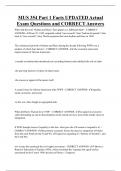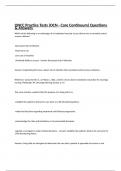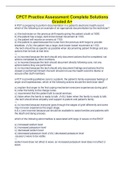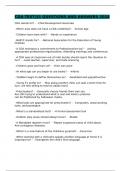MUS 354 Part 1 Facts UPDATED Actual
Exam Questions and CORRECT Answers
When did the term "rhythm and blues" first appear as a billboard chart? - CORRECT
ANSWER- ✔✔June 25, 1949; originally called "race records", then "harlem hit parade", then
back to "race records"; Jerry Wexler proposed the term rhythm and blues in 1949.
The commercial growth of rhythm and blues during the decade following WWII was a
product of which four factors? - CORRECT ANSWER- ✔✔-the economic and social
empowerment of African Americans
-a media revolution that introduced new recording formats and redefined the role of radio
-the growing interest of whites in black music
-the crossover appeal of the music itself.
A central issue for African Americans after WWII - CORRECT ANSWER- ✔✔equality;
racial, economic, and social
-in the war, often fought in segregated units
What did Harry Truman do in 1948? - CORRECT ANSWER- ✔✔he signed an executive
order demanding an end to discrimination in the armed services; moved the needle closer to
integration
If WWI brought issues of equality to the fore, what gave the US reason to respond to it? -
CORRECT ANSWER- ✔✔the postwar economic boom, the massive emigration of blacks
from the rural South (to the N and W), US hypocrisy regarding it's "defense of freedom", and
the Cold War
two events that catalyzed the civil rights movement - CORRECT ANSWER- ✔✔-Brown v.
Board of Education of Topeka (1954), which rescinded the "separate but equal" policy
sanctioned by the Court's 1896 decision in Plessy v. Ferguson.
,- In 1955, Montgomery, AL, Rosa Parks refused to give up her bus seat to a white person.
When she was arrested and sent to jail, blacks in Montgomery boycotted the municipal bus
service for a year. Two years later, Dr. Martin Luther King Jr. organized the Southern
Christian Leadership Conference, which advocated nonviolent protest modeled after that used
by Mahatma Gandhi in India.
how did R&B artists contribute to the civil rights movement in the postwar years? -
CORRECT ANSWER- ✔✔indirectly; the appeal of their music heightened awareness of
black culture
-at the same time, R&B also benefited from the increased media attn. to U.S. race relations
which two developments triggered a media revolution in the 1950s? - CORRECT ANSWER-
✔✔the emergence of commercial television and the development of new record formats
-opened the door for R&B
what happened to the TV industry after WWII? - CORRECT ANSWER- ✔✔it mushroomed;
In 1946, the industry only sold 6,000 television sets.
-in 1949, sales topped 2 million sets.
-By the mid-fifties, television was a household staple, and the first color sets were on the
market.
-Television quickly took over radio's role as the primary source of all-purpose entertainment.
what happened when TV took over radio's role as the primary source of American
entertainment? - CORRECT ANSWER- ✔✔radio re-defined itself as a medium, and began
playing recorded music.
-most prominently played pop, but other stations offered alternatives, often broadcast at odd
times (i.e. late-night, early morning)
,-Disc jockeys (DJs), a new breed of radio personality created by this phenomenon, hosted
these shows.
-Listeners tuned in for the DJ as well as the music.
-During these early years of radio programming, DJs chose their own music. As rhythm and
blues and rock and roll caught on, their ability to choose the music that they played gave
them enormous clout, which they abused on occasion
What happened to record formats postwar? - CORRECT ANSWER- ✔✔-Shellac 78s had
dominated the market; delivered about three minutes of popular music on 10-inch discs and
about four minutes of classical music on 12-inch discs.
-In 1948, Columbia Records began issuing long-playing (LP) records, that revolved at 33
rpm. These were vinyl discs that held over half an hour of music and didn't break when you
dropped them.
-in 1949, RCA brought out the 7-inch 45 rpm single. This disc was also vinyl and, despite its
much smaller size, also held about three minutes of music.
-It took a while for these new formats to catch on because they required new record players.
However, by the mid-fifties, the new 45 rpm format had largely replaced the 78.
-45s were directed at teens because of their convenience and durability
what is BMI? - CORRECT ANSWER- ✔✔-Broadcast Music Incorporated
-a music licensing agency created in 1939 to collect fees on behalf of those clients (blues and
country musicians) not represented by ASCAP, the licensing organization for pop songwriters
and performers.
how did the development of BMI impact the music industry? - CORRECT ANSWER- ✔✔-
completed the infrastructure that allowed independent artists to come on to the commercial
scene
, -indie industry grew in the late 40s and early 50s
-40s indie pioneer Leonard Chess sold his 45s from the trunk of his car
In the 40s and 50s, what was indie music? - CORRECT ANSWER- ✔✔-country and blues,
mostly from black artists
what was the Macomba? - CORRECT ANSWER- ✔✔A club owned by Leonard and Phil
Chess on Chicago's southside; featured prominent black artists of the day.
-In 1947, the bros. sensed the market and opened Aristocrat records, their label
-The first releases on the new label featured jazz and jump band performers. Over the next
several years, they added such key figures as Muddy Waters and Chuck Berry to their roster.
Important indie labels - CORRECT ANSWER- ✔✔-Aristocrat Records (Brothers Chess,
Chicago 1947)
-Atlantic Records (Ahmet Ertegun, NYC, 1947)
-Art Rupe's Specialty Records based in New Orleans, Lew Chudd's Imperial Records based
in Los Angeles, and Syd Nathan's King Records based in Cincinnati, all helped preserve and
disseminate the sound of rhythm and blues (and country and western).
-Sam Phillips's Sun Records. His recording studio, the only place that blacks could record in
Memphis, also recorded top rockabilly acts, beginning with Elvis Presley.
-The only record label that became major was Atlantic
Among the most important developments in rhythm and blues during the decade that
followed World War II were: - CORRECT ANSWER- ✔✔-Up-tempo good-time blues styles
with a strong beat and/or backbeat








